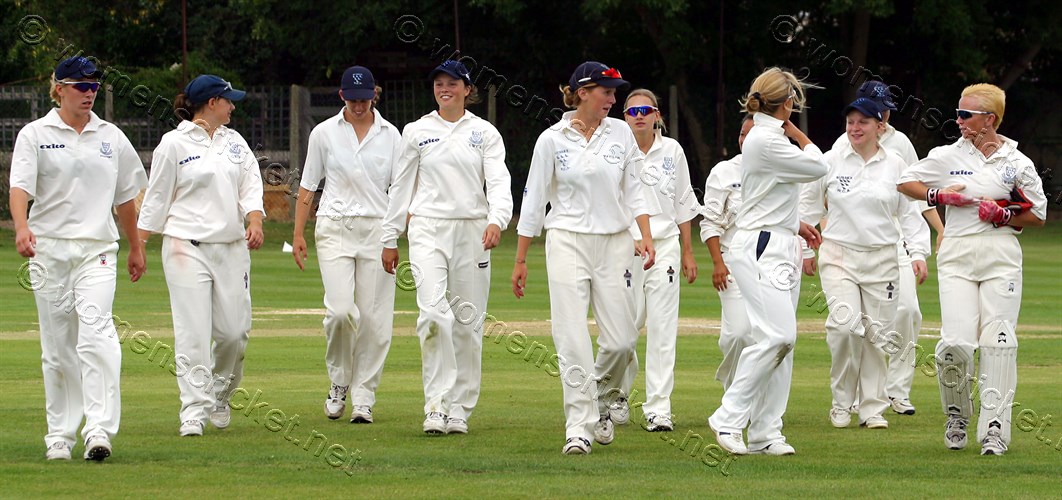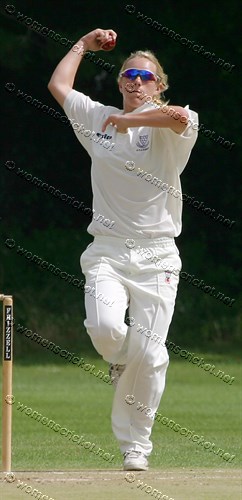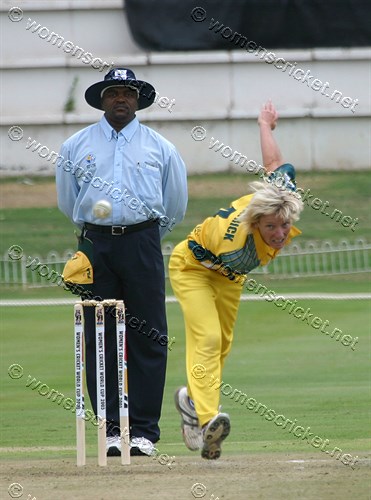Previous Page (From
Skirts to Pink Balls - part 1)
From Skirts to Pink Balls (part 2)
I had an interest in computers and
what they could in the
earliest days, having a scientific background. I bought a BBC micro very early on (no - I realise
you'll not have heard of it) and played with writing software in BBC
Basic, a language that was definitely 'one-up' on basic Basic (if you
see what I mean...). Working
with just 64k of RAM initially - yes - I said 64k - note the 'k' - I
wrote a database that printed labels for a charity magazine distribution I was
involved with and that I could also print out as a simple list for the
committee's use. I am still working with that charity to this day. Thus when I became aware of the web I thought - ah, a
web site for women's cricket, and this site (then with a different URL) was born.
I have to admit, in total honesty, that one web site
beat me to it and that was Roz Tritton with the Oxford University
Women's team. However Roz left university and the site became
moribund. It
has more recently been revived. Thus I can boast of having the
oldest continuously updated web site devoted to the sport on the
Internet. This site earned a listing in the "GOOD web site GUIDE" in
2005.
In 2002 a new tournament sprung up
providing cricket at a level above that of the County Championship in
which 48 or so of the top players in the country were divided
into four teams to play in the "Super 4s". Originally the teams were
allowed to chose their own names. The result was "Braves", Super
Strikers", "Knight Riders" and "V Team". At first this was just a 50-over competition. Later a T20 was
introduced and the team names changed to that of jewels, "Diamonds",
"Emeralds", "Rubies" and "Sapphires". The colours of the kit did
not always reflect the expected colours from the most common version of
the stones in question. In the examples below, however, you should be
able to guess which team the player represents.
![[Beth Morgan] © Don Miles [Beth Morgan] © Don Miles](pow/070602_036-Morgan-Beth-4s.jpg) ![[Isa Guha] © Don Miles [Isa Guha] © Don Miles](pow/070616_035-Guha-Isa-4s.jpg)
Beth Morgan (left) and Isa Guha
![[Jasmine Titmuss] © Don Miles [Jasmine Titmuss] © Don Miles](pow/070708_045-Titmuss-Jasmine-4s.jpg) ![[Anya Shrubsole] © Don Miles [Anya Shrubsole] © Don Miles](images17/070603_075-Shrubsole-Anya-4s.jpg)
Jasmine Titmuss (left) and Anya Shrubsole
This tournament provided some
excellent cricket although no one was really sure of the purpose of these
matches. Was it an England trial, or maybe simply a chance for the
England players to warm-up against quality opposition? It often seemed
like the latter with batsmen like Charlotte Edwards cracking centuries
while some of those who might have had hopes of making England one day
seemed to be simply canon fodder. I certainly enjoyed watching the results
whatever the intention.
In the early 'naughties' digital cameras
started to arrive on the scene. Long lenses, necessary for action shots,
were however, on the expensive side and rather variable in quality. That
didn't prevent shots like that below...

The Sussex Team Leave the Pitch after a Match in
2003
However, for action shots, choose your angle
carefully (in this instance the player is running towards you so you can get away with a
fairly low shutter speed) and even a poor lens gives a picture which
looks OK at the 96dpi of a modern screen. It was fine, of course, in those
days when 72dpi was the norm.

Rosalie Birch
Today it's possible, even with a camera
that's far from the latest model, to take action shots that will look
good when printed at A3 or even larger. But don't try printing them
large with your iphone pic. The iphone is not really a camera
for distance work (so I'm told).
In 2005 I decided on my first cricket
adventure abroad following Clare Connor's England team to the World
Cup around Pretoria in South Africa.
The event was to be the
swansong of the IWCC, the International Women's Cricket Council. The
organisation was wound up at a dinner at the end of that tournament to
which I was unexpectedly invited. I had no formal clothes on the trip to wear and
declined for that reason, but was told very firmly I would be going
with the following advice - "hang a camera over your shoulder and
everyone will think you're working". Needless to say I obliged! But I
am getting ahead of myself. The trip was most enjoyable; even a brush
with an inspector at Jo'burg airport on arrival. He asked if I had any foodstuffs
with me and rather jokingly (and possibly unwisely) I said "yes" and
unwrapped a bag of sweets. He promptly pinched one and waved me on
with a broad smile.
Travelling with the parents of Claire Taylor and the
mother of Clare Taylor (confusing isn't it? A solution
later attempted by the ECB didn't quite work), we were later joined by
Clare Connor's father. I could easily have felt the odd-man-out but
the holiday was as relaxing on non-cricket days as it was enjoyable at
the matches. England were sadly defeated in the semi-final stage by
Australia due in no small part from what I think must be the finest
piece of quick bowling I have seen to this day. Cathryn Fitzpatrick
was always known to be the quickest around by quite a margin, but that
day she had everything, speed, control, swing; it was amazing to watch such a
fine bowling performance, even if you sat there wishing another team
was on the wrong end of it. Her figures from
this match do not reflect the effect she had on the game. Note her
10 overs 3-27 includes England's top three! Clare Connor and Arran
Brindle put up a spirited defence and Clare Taylor, running like the
wind, gave the score some small respectability. Australia managed
three run outs in the reply but crossed the line in 47 overs.

Cathryn Fitzpatrick, possibly the quickest bowler
the sport has produced to date, in full flow
at the semi-final against England in the 2005 World Cup.
One amusing incident occurred during
the final (in which, incidentally India were robbed of a chance to win
by the worst umpiring decision I have ever seen!). Later the umpires called
for a TV answer on a line decision. We sat and waited and I heard the
England captain's phone beep. It turned out it was her mother from England - "she's out". We knew it before the umpires on the field!
I have to thank South Africa for its
hospitality. We played on club grounds around Pretoria almost all of
which were of a high standard, food in the restaurants was cheap and
of good quality and some of the steaks in the pub around the corner
from our small hotel still make my mouth water at the thought of them.
I was also introduced to my first game of Rugby Union when we discovered
there was a game being played very close to our hotel. It was
apparently between two of the best teams in the southern hemisphere as
the local "Bulls" took on the "Christchurch Crusaders" from New
Zealand. I have long since forgotten who won but it was a new and
interesting experience. On a cricket commentary from New Zealand early
in 2017 I discovered the ground is one of the iconic grounds of the
sport and the commentators were speaking of it in the same terms that
for ages I spoke of Newlands, Cape Town - somewhere I simply had to
watch a game. It seems I picked the right place for my one and only
(to date) rugby union game. Newlands has now been ticked off the
'bucket' list as I'll reveal later.
And incidentally how did the ECB attempt to make it
easier to distinguish between two "Taylor"s on the pitch? Simple - you
add an initial - but unfortunately two "C.Taylor"s didn't help much.
But South Africa provided so much more
than the cricket alone. A safari with an excellent guide produced
great views of so many animals... I think I used as many frames on the
wildlife as on the cricket - well - very nearly anyway.

A rhino with a youngster who seemed totally
unconcerned when we were just a few feet away,
perhaps not a sensible place to be without a very expert guide

A malachite kingfisher contemplates his next meal
![[line]](images/line.png)
Next Page : From Skirts
to Pink Balls (part 3)
|
![[Beth Morgan] © Don Miles [Beth Morgan] © Don Miles](pow/070602_036-Morgan-Beth-4s.jpg)
![[Isa Guha] © Don Miles [Isa Guha] © Don Miles](pow/070616_035-Guha-Isa-4s.jpg)
![[Jasmine Titmuss] © Don Miles [Jasmine Titmuss] © Don Miles](pow/070708_045-Titmuss-Jasmine-4s.jpg)
![[Anya Shrubsole] © Don Miles [Anya Shrubsole] © Don Miles](images17/070603_075-Shrubsole-Anya-4s.jpg)




